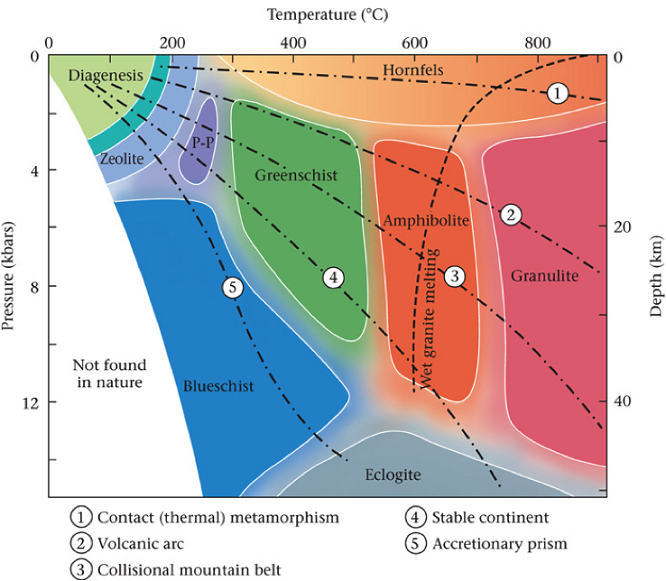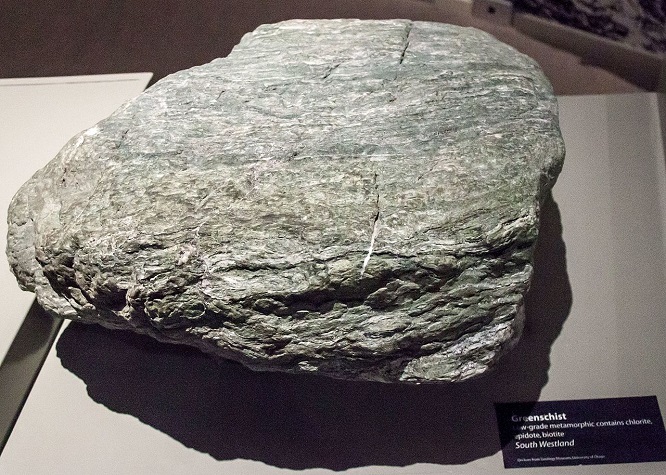Greenschist
Greenschist is a fine- to medium-grained foliated metamorphic rock dominated by chlorite, actinolite and epidote, with or without albite, quartz and calcite. Greenschists form by regional metamorphism of mafic igneous rocks, usually basaltic rocks, under greenschist facies metamorphism (usually produced by regional metamorphism, typically 300–450 °C and 1–4 kilobars). The name comes from commonly having an abundance of green minerals such as chlorite, serpentine, and epidote, and platy minerals such as muscovite and platy serpentine.Greenschist facies is determined by the particular temperature and pressure conditions required to metamorphose basalt to form the typical greenschist facies minerals chlorite, actinolite, and albite. Metamorphic conditions which create typical greenschist facies assemblages are called the Barrovian Facies Sequence, and the lower-pressure Abukuma Facies Series. The equilibrium mineral assemblage of rocks subjected to greenschist facies conditions depends on primary rock composition.
Mafic protolith: chlorite + actinolite + albite ± epidote
Ultramafic protolith: chlorite + serpentine ± talc ± tremolite ± diopside ± brucite
Pelitic protolith: quartz ± albite ± k-feldspar ± chlorite, muscovite, garnet, pyrophyllite ± graphite
Carobonatic protolith: calcite ± dolomite ± quartz ± micas, scapolite, wollastonite.
The greenschist facies can be subdivided into:
- lower greenschist: Lower temperatures are transitional with and overlap the prehnite-pumpellyite facies
- upper greenschist: higher temperatures overlap with and include sub-amphibolite facies.
If burial continues along Barrovian sequence metamorphic trajectories, greenschist facies gives rise to amphibolite facies assemblages, dominated by amphibole and eventually to granulite facies. Lower pressure, normally contact metamorphism produces albite-epidote hornfels while higher pressures at great depth produces eclogite.

The common metamorphic facies. The boundaries between the facies are depicted as wide bands because they are gradational and approximate. P-P = Prehnite-Pumpellyite facies.

Greenschist sample. From Wikimedia.
Bibliography
• Bucher, K., & Grapes, R. (2011). Petrogenesis of metamorphic rocks. Springer Science & Business Media.
• Fossen, H. (2016). Structural geology. Cambridge University Press.
• Howie, R. A., Zussman, J., & Deer, W. (1992). An introduction to the rock-forming minerals (p. 696). Longman.
• Passchier, Cees W., Trouw, Rudolph A. J: Microtectonics (2005).
• Philpotts, A., & Ague, J. (2009). Principles of igneous and metamorphic petrology. Cambridge University Press.
• Shelley, D. (1993). Igneous and metamorphic rocks under the microscope: classification, textures, microstructures and mineral preferred-orientations.
• Vernon, R. H. & Clarke, G. L. (2008): Principles of Metamorphic Petrology. Cambridge University Press.
• Vernon, R. H. (2018). A practical guide to rock microstructure. Cambridge university press.


.jpg)
.jpg)
.jpg)
.jpg)
.jpg)
.jpg)
.jpg)
.jpg)
.jpg)
.jpg)
.jpg)
.jpg)